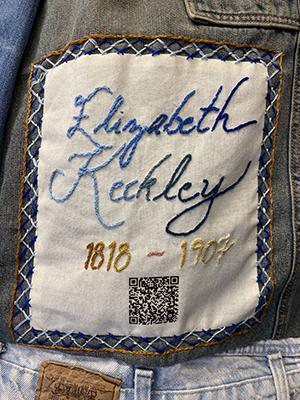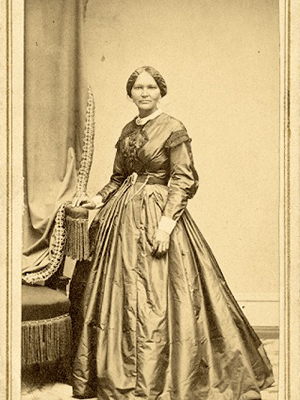Elizabeth Keckley
Elizabeth Keckley was born in February of 1818 in Virginia. Her mother, an enslaved seamstress named Aggy, was raped by her owner, Colonel Armistead Burwell. Elizabeth recalled that her first assignment as an enslaved five-year-old child was to care for her white father's infant daughter. She wrote:
 Aamna Tirmazi ’27
Aamna Tirmazi ’27
My old mistress encouraged me in rocking the cradle, by telling me that if I would watch over the baby well, keep the flies out of its face, and not let it cry, I should be its little maid. This was a golden promise, and I required no better inducement for the faithful performance of my task. I began to rock the cradle most industriously, when lo! out pitched little pet on the floor. I instantly cried out, "Oh! the baby is on the floor;" and, not knowing what to do, I seized the fire-shovel in my perplexity, and was trying to shovel up my tender charge, when my mistress called to me to let the child alone, and then ordered that I be taken out and lashed for my carelessness. The blows were not administered with a light hand, I assure you, and doubtless the severity of the lashing has made me remember the incident so well. This was the first time I was punished in this cruel way, but not the last.
Luckily, Aggy taught her daughter how to sew, and she took that skill to new heights after her father died and the family was forced to move. Elizabeth’s talents as a dressmaker earned her a clientele of well connected society ladies. She was recommended to First Lady Mary Todd Lincoln and was soon her close confidant in the White House. She was there when Willie, the President’s 11 year old son died from typhoid fever. She wrote in her memoir:
I assisted in washing him and dressing him, and then laid him on the bed, when Mr. Lincoln came in. I never saw a man so bowed down with grief. He came to the bed, lifted the cover from the face of his child, gazed at it long and earnestly, murmuring, "My poor boy, he was too good for this earth. God has called him home. I know that he is much better off in heaven, but then we loved him so. It is hard, hard to have him die!"
Elizabeth’s own son, George, had just died six months earlier, fighting with the Union forces and she and the First Lady consoled each other. Mary, sick with grief, wrote to her husband that she needed to get away for her mental health, “A day of two since, I had one of my severe attacks, if it had not been for Lizzie Keckley, I do not know what I should have done.”
While caring for Mary and running a successful dressmaking business, Elizabeth made time to help those in need. She founded an association to give aid to the enslaved refugees who were camping in the capital. These men and women were legally considered “contrabands of war” until white policymakers determined whether they were enslaved property or free citizens.

On the morning April 15, 1865, the First Lady was informed that her husband was indeed dead. When asked who she wanted to comfort her, she said, “send for Elizabeth Keckley. I want her just as soon as she can be brought here.” Elizabeth stayed by her side until Mary moved out. Years later, when Mrs. Lincoln found herself deeply in debt, she called on Elizabeth once again to help her sell off several of her beloved gowns. The dresses failed to garner enough money to bail Mary out, and their reputations were tarnished in the scheme. In an effort to redeem both of their good names, Elizabeth wrote the first tell-all celebrity memoir.
In 1868 she published "Behind the Scenes or Thirty Years a Slave, and Four Years in the White House." She told a detailed account of her own enslavement, her intimate conversations with Washington’s elite women, and her relationship with Mary, which shocked society. The book was suppressed and Elizabeth’s clientele deserted her. Undaunted, she moved to Ohio and became the Head of Wilberforce University’s Department of Sewing and Domestic Science Arts and trained the next generation of Black dressmakers.